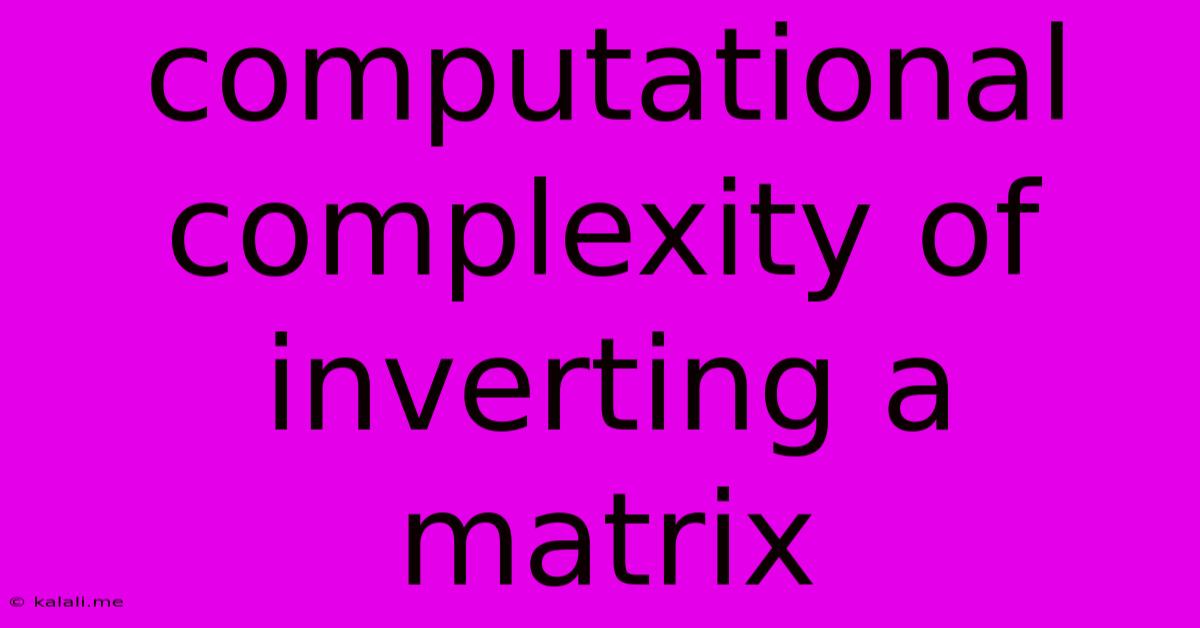Computational Complexity Of Inverting A Matrix
Kalali
May 23, 2025 · 4 min read

Table of Contents
The Computational Complexity of Inverting a Matrix
Inverting a matrix is a fundamental operation in linear algebra with wide-ranging applications in computer science, engineering, and scientific computing. Understanding its computational complexity is crucial for designing efficient algorithms and predicting the runtime of matrix-based applications. This article delves into the complexity of matrix inversion, exploring different algorithms and their associated time complexities. We'll also touch upon the impact of matrix properties on computational cost.
What is Matrix Inversion?
A square matrix A is invertible (also called non-singular) if there exists a matrix A⁻¹ such that A * A⁻¹ = A⁻¹ * A = I, where I is the identity matrix. Finding this inverse matrix, A⁻¹, is the process of matrix inversion. This operation is vital for solving systems of linear equations, finding determinants, and performing other linear algebra tasks.
Algorithms and Their Complexities
Several algorithms exist for computing the inverse of a matrix. The choice of algorithm often depends on the matrix's size, properties (e.g., sparsity, symmetry), and the desired accuracy. Here are some common methods and their associated complexities:
1. Gaussian Elimination (with partial pivoting):
This is a widely used method for solving systems of linear equations, which can be adapted for matrix inversion. It involves performing elementary row operations to transform the matrix into its row echelon form and then back-substitution to find the inverse.
- Time Complexity: O(n³), where 'n' is the dimension of the square matrix. This cubic complexity makes it computationally expensive for large matrices.
2. LU Decomposition:
LU decomposition factorizes a matrix into a lower triangular matrix (L) and an upper triangular matrix (U). Once the LU decomposition is obtained, the inverse can be efficiently computed.
- Time Complexity: O(n³). While the overall complexity remains cubic, LU decomposition can offer advantages in certain scenarios, particularly when multiple systems of equations with the same coefficient matrix need to be solved.
3. Strassen Algorithm:
Strassen's algorithm is a divide-and-conquer algorithm that cleverly reduces the number of multiplications needed compared to the naive cubic approach.
- Time Complexity: O(n^log₂7) ≈ O(n^2.81). This sub-cubic complexity offers a significant improvement over Gaussian elimination for very large matrices. However, the constant factors involved can make it less efficient for smaller matrices due to the overhead of the divide-and-conquer approach. It also becomes less numerically stable than Gaussian elimination for some matrices.
4. Coppersmith-Winograd Algorithm and its Variants:
These algorithms offer even lower asymptotic complexities, but they are highly complex and not generally used in practice due to their large constant factors and limited numerical stability. Their theoretical improvements are significant but only become practically advantageous for exceptionally large matrices.
- Time Complexity: The current best-known algorithms achieve complexities slightly better than O(n²) but are not practical for real-world applications.
Impact of Matrix Properties
The computational complexity can be influenced by the specific properties of the matrix being inverted:
-
Sparse Matrices: If the matrix contains a large number of zero elements, specialized algorithms can significantly reduce the computational cost compared to general-purpose methods. These algorithms exploit the sparsity to avoid unnecessary computations.
-
Symmetric Matrices: Symmetric matrices (A = Aᵀ) can be inverted more efficiently using algorithms that take advantage of this symmetry.
-
Structured Matrices: Matrices with specific structures (e.g., Toeplitz, Hankel) allow for specialized algorithms that often outperform general-purpose methods.
-
Condition Number: The condition number measures a matrix's sensitivity to small changes in its entries. A high condition number indicates that the matrix is ill-conditioned, making the inversion process more prone to numerical errors and potentially increasing the computational cost due to the need for higher precision arithmetic.
Conclusion:
The computational complexity of matrix inversion is primarily O(n³), but advancements like Strassen's algorithm have pushed the boundaries towards sub-cubic complexities. However, practical considerations like numerical stability and constant factors often favor Gaussian elimination or LU decomposition for many applications. The choice of algorithm should carefully consider the size, properties, and condition number of the matrix involved to achieve the best balance between computational efficiency and accuracy. Understanding these complexities is crucial for optimizing performance in applications that heavily rely on matrix operations.
Latest Posts
Latest Posts
-
Which Of The Following Is True Concerning A Dao
Jul 02, 2025
-
How Long Can Catfish Live Out Of Water
Jul 02, 2025
-
Is Kanye West Related To Cornel West
Jul 02, 2025
-
Olivia Needs To Provide A Visual Summary
Jul 02, 2025
-
How Many Cups Of Macaroni In A Pound
Jul 02, 2025
Related Post
Thank you for visiting our website which covers about Computational Complexity Of Inverting A Matrix . We hope the information provided has been useful to you. Feel free to contact us if you have any questions or need further assistance. See you next time and don't miss to bookmark.